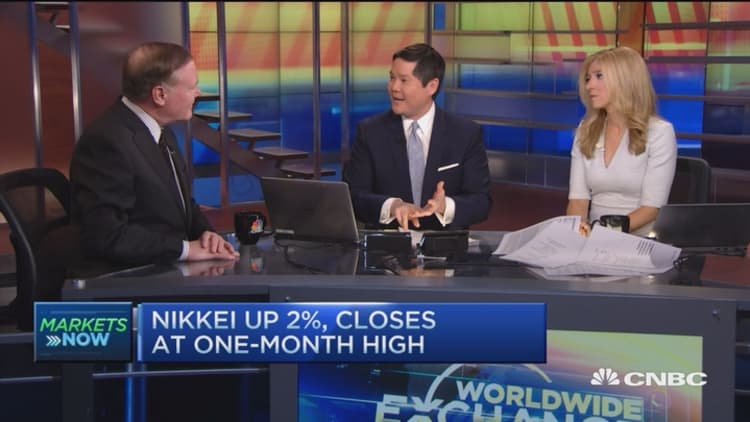
The "selling stampede" that contributed to the worst January for the Dow and since 2009 may have ended with the start of a two-day rally last week, Raymond James strategist Jeffrey Saut said Monday.
"I think it ended last Thursday," Saut told CNBC's "Worldwide Exchange," adding that such sales rushes generally last 17 to 25 sessions.
"You have to string together at least three consecutive positive days to break a selling stampede. We've had two, so we'll see if we can do it. This week is critical in terms of doing that," he added.
U.S. stock futures pointed to a lower open on Monday. The Dow ended January down 5.6 percent, while the S&P 500 fell 5.2 percent on the month. The Nasdaq plunged 8 percent for its worst January since 2008.
In December, Saut forecast a "rip your face off-type rally" that failed to come to pass. He attributed that to the expiration of $1.2 trillion worth of options and futures that destroyed the markets rhythm.
Earlier last year, Saut accurately called a market bottom during August's sell-off.
Saut said he believes the U.S. economy is stronger than it seems, although he acknowledged last week's below-expectation fourth quarter GDP reading, which showed the U.S. economy grew at just 0.7 percent.
As for the recent outperformance of defensive stocks like utilities, consumer staples, and dividend-paying equities, Saut chalked that up to seniors who are "desperately seeking savings" in an environment where yield is hard to come by in money markets and bonds.
"Dividend-paying stocks, utilities is where you get you income from. I think that's a theme going forward. I think it's a long-last[ing] theme," he said.
Saut also likes financial stocks on the view that they are underpriced and the expectation of consolidation in the industry in the coming decade.
Christopher Wolfe, chief investment officer at Merrill Lynch Private Banking and Investment Group, also sees those categories outperforming.
In a low-and-slow growth economy, those sectors contain many of the companies with healthy cash flow and low debt, and the ability to turn revenue growth — even if it's moderate — into operating income, Wolfe said.
"That kind of focus for the market this year I think will segment further. We've seen investors pay up for those companies," he told CNBC's "Squawk Box" on Monday.
With corporate earnings down about 5 percent year over year and guidance for 2016 looking weak, Wolfe said he sees the market moving on economic data and expectations of monetary policy.

The Federal Reserve in December raised interest rates for the first time in more than nine years. The Fed's policymaking committee last week left rates unchanged, but stuck with earlier indications that it expects to raise rates four times this year, above market expectations.
Anthony Chan, chief economist at Chase, said Monday he would be surprised to see the Fed raise rates more than once or twice, in no small part because central banks around the world are easing monetary policy, which effectively results in tighter monetary conditions in the United States.
While some believe the manufacturing sector has entered a recession, the services sector, which makes up a larger part of the economy, is still expanding, if not as quickly as most would like, Chan told "Squawk Box."
As such, fear that weakness in manufacturing will spill over into the broader economy is overblown, he said. More troubling are fresh signs of weakness in China, where data released on Monday showed the manufacturing sector contracted for the sixth month in a row.
"If China suffers a hard landing — we don't expect that — but if it does, it will impact other emerging markets," he said. "And when you look at other emerging markets, along with China, that can spill over not only to the United States, but to the rest of the global economy."
For that reason, Chan puts the chances of a U.S. recession at roughly 25 percent.


